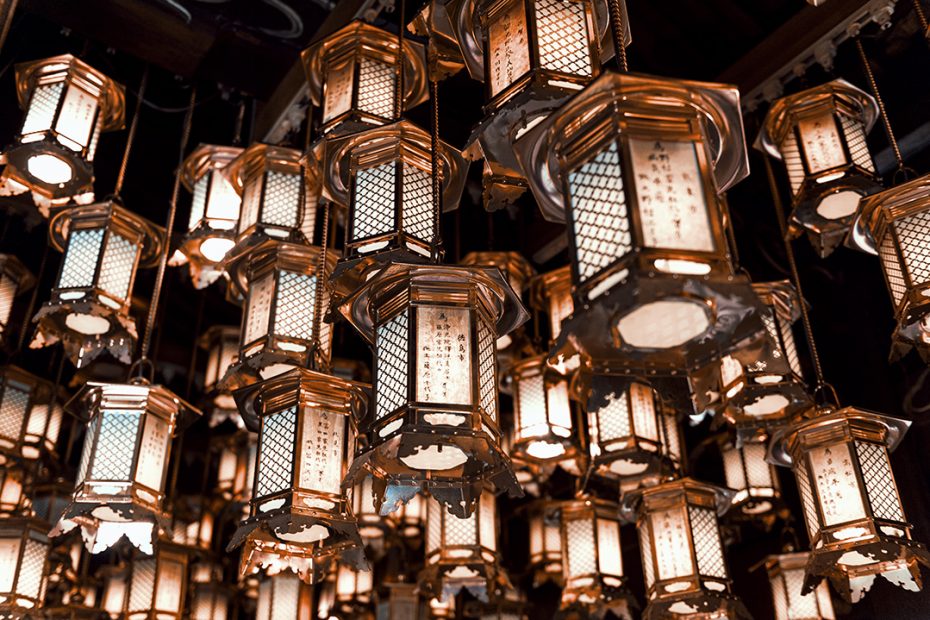これは正真正銘、私が日本について初めて書いた記事です。これまでで最も懸命に仕上げ、自分の中では今もお気に入りの一つです。私自身が体験した、四国八十八か所の全行程を巡る1200㎞の旅路を題材にしたものです。
当時はまだ、カメラの仕事をしていなかったものの、カメラは巡礼に持っていきました。安いペンタックスSLRに白黒フィルムを入れ、2 ~3本撮りました。
(下の記事は、2001年に初めて『Look Japan』誌に掲載されました)
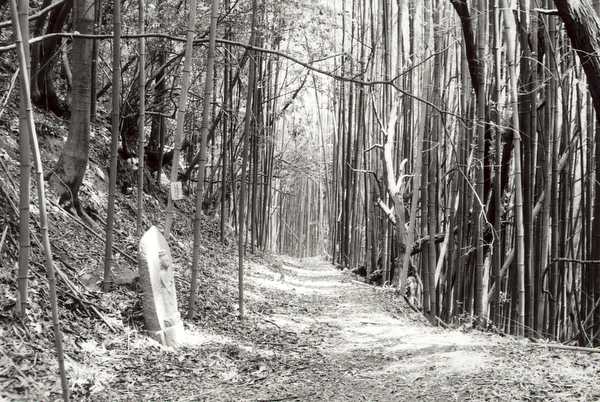
On Being a Pilgrim
THE old lady looked me up and down, threw a glance at my bulging rucksack, and peered quizzically into my road-weary eyes. She smiled as I crammed the groceries into my pack and clumsily hefted it onto my aching shoulders.
“Aren’t you lucky? The pilgrimage will give you strong legs and a strong heart.”
I mustered a weak smile, nodded goodbye and set out to find somewhere to pitch my tent for the night.
Over the years hundreds of thousands of people must have completed the Shikoku pilgrimage, each of them visiting 88 Buddhist temples strung out like beads on a rosary about the perimeter of Japan’s fourth largest island. The pilgrimage is by far the most famous and popular in Japan. The majority of contemporary pilgrims (or henro) travel by tour bus, some by car and taxi, and a few hardy, or perhaps foolhardy, souls undertake the journey the way henro once did of necessity–by foot. Walking involves about 1,200 kilometers and at least 40 days of urban sprawl, wind-swept seashores and mountain passes cut deep by the feet of countless pilgrims.
The beginnings of the pilgrimage are said to date back to the ninth century when the Buddhist priest Kukai, later to be canonized as Kobo Daishi, made a journey around the island in his search for enlightenment. The route, which takes in 88 main temples and numerous additional temples, is believed to be comprised of several ancient local pilgrimages, which at some point after the time of Kukai combined to form the present route. Kukai was the founder of the Shingon Buddhist sect, also known as Mikkyo, “the secret teachings.” It’s a rich, atmospheric religion, steeped in Chinese magic and Japanese mountain mysticism, so different from the austere Zen aesthetic more commonly associated with Japan.
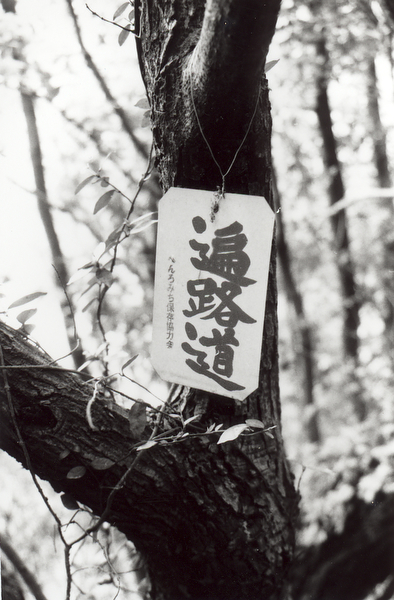
My own journey began at the beginning of April. The Japanese climate leaves Only a couple of two or three-month windows for walking–one in the spring and one in the fall. In fact, I’d chosen the peak season to set off and temple number one, Ryouzen-ji, was abuzz with people. There I bought a staff, a white henro coat, and a small white satchel to carry my stamp book. The latter was to contain the calligraphy and seals I would obtain at each temple along the route. Undoubtedly, of those the staff was the most important. With their staff (or tsue), a symbolic replacement for Kobo Daishi, in a sense everyone traveling the pilgrimage walks with the Saint. My staff had “Dou gyou ni-nin” (we two walk together) written with careful brush strokes along its length. Like every pilgrim, I was at pains to take good care of my staff. When I arrived at a minshuku (inn) I would meticulously wash its base and lean it in the corner of the room, and the nights I spent in my tent, Kobo Daishi slept by my side. I’m not embarrassed to admit that during some solitary stretches of the route I would talk to my companion. And, I like to think that Kobo Daishi looked after me too. I lost count how many times, top heavy from my hefty rucksack, that the staff saved me from a nasty tumble.
Having set out from temple one I soon discovered I wasn’t alone walking the route. Apparently, in recent years the numbers of henro eschewing the tour bus and car have increased, although each year only a few hundred pilgrims have the time, money or strength to undertake the journey on foot. While I invariably encountered busloads of immaculately outfitted henro at the temples themselves, the long roads and mountain paths were left to the walkers. Occasionally I’d overtake or be overtaken by another pilgrim and I often met other henro when I stopped for the night, but strangely it was unusual to see people walking together. The further I progressed the fewer I saw. Perhaps it’s easier to find a comfortable pace on your own, and there’s pleasure and a kind of purpose in losing yourself among your own thoughts. In any case, I never felt lonely during my walk.
No Discouragement
The island of Shikoku is made up of four prefectures, which pilgrims must pass through in turn. Traditionally, they represent four stages on the path to enlightenment. The first prefecture, Tokushima-ken was probably the easiest. I’d deliberately set a relaxed pace, and I’d met many other henro among the temples clustered at the beginning of the route. It was on leaving the prefecture, entering Kochi-ken and embarking on the 80-kilometer trek to Muroto-zaki (cape) that I faced the first real challenge of the trip. One long undeviating empty road along the coast, three days of raw salt air and blinding sun from out over the Pacific. Within a couple of hours of setting out I’d been forced to fashion a makeshift veil to protect my neck and face. Peering ahead of my blinkers I could just make out drivers turning their heads in astonishment at this strange pilgrim Lawrence of Arabia. Yet, as so often happened during my journey, the most arduous experiences were just precursors to the most moving and beautiful. Exhausted I’d camped on the beach at Muroto-zaki just below the steep hill and temple number 24, Hotsumisaki-ji. The next morning I was up in time to see a breathtaking sunrise. Clutching a hot can of coffee to warm my hands against the chill spring morning, I sat on a high rock and watched spellbound as gilt-winged eagles circled over the kindling horizon.
Kochi-ken is noted for being a test of endurance. Full of long lonely roads and with fewer temples and further to walk than any other part of the pilgrimage, I found its reputation to be well deserved. Almost two weeks into the journey, my body was beginning to let loose a veritable cacophony of squeaks, grumbles and groans. It’s quite remarkable how much one can learn about one’s own body through physical discomfort. Time and again I was astonished to discover that a leg, groin or shoulder muscle I didn’t even know I had could provide so much pain. Around day 15 I was convinced that my shoulder muscles were ripping, the bones in my feet cracking and my vertebrae grinding to dust. Then, at the end of a crescendo of pain, when I was all but convinced that my adventure would soon come to an excruciating and ignominious end, the pain slowly began to dissipate and a week later I was left only with the inevitable aches and fatigue that walking 30 kilometers a day brings.
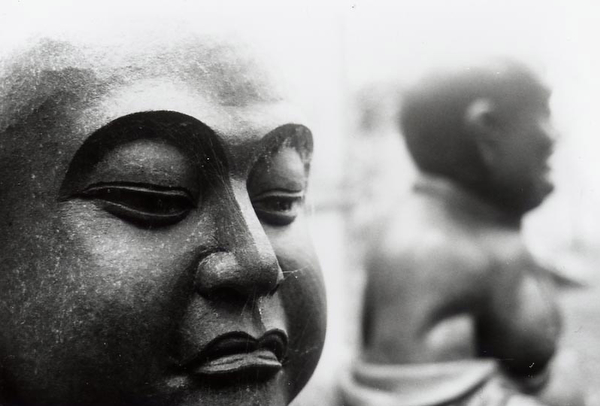
Soon I reached the half-way point of the pilgrimage, and by that point I’d already met the henro who were to be my occasional companions during most of the trip. Early on, in busy, sociable Tokushima-ken, I’d made friends with a cheery straggle-bearded trainee monk from Kyoto called Miyagi. Unbelievably, he’d set out on the trip with no previous experience of hiking. When I first met him he was hobbling along in gym shoes and attempting to balance a small rucksack and two battered travel bags on his shoulders. That day we re-packed his bags and we spent a good part of the following day looking for some sturdier boots. About then, I made another friend who I was to see many times, a retired photocopier salesman whose name I never caught and was too embarrassed to ask for afterwards. Several times I recognized him approaching in the distance by his energetic strides and his conspicuous emerald colored hat. I remembered him as “Green Hat.” Of the walkers I met along the way, apart from a handful of students, most were retired like Green Hat. Funnily, most of these pilgrims seemed less interested in the religious aspects of the pilgrimage than the hiking. Green Hat even confided to me that he wasn’t particularly fond of Buddhism. All the same, he had an encyclopedic knowledge of the plants and animals we passed and an obvious love of the countryside.
The Kindness of Strangers
It was in Ehime-ken, the third of the four prefectures, that I had one of the most touching experiences of my journey. Not for the first time, I had arrived in a small village with little idea about where to stay apart from sketchy secondhand advice from henro I’d met earlier along the route. But, with a welcoming kindness I’d already come to know well, the villagers patiently heard out my mangled Japanese and helped me find somewhere to stay. This night it was a little Shingon shrine on a wooded hillock outside the village. Quite a luxurious stay after nights of train station benches, bus stops, parks and only the occasional minshuku. With kilometers of road and pounds of rucksack weighing on my eyelids, I slept early and soundly, and it was soon after dawn the next day when I woke to the sound of gentle rain. Just as I was stiffly extricating myself from my sleeping bag I heard the sound of footsteps approaching the shrine and a middle-aged lady open the doors to find me sitting on the tatami in my boxer shorts. She explained how she’d come to pray with her son and daughter and invited me to join them. After I’d moved my kit to the side of the room we knelt and prayed Kobo Daishi. She told me how her family came once a month to this little shrine to pray. What for she didn’t say, but I couldn’t help wondering at the absence of the father of the family. Perhaps they were praying for his health. They’d brought juice, sweets, cakes and a little money to place on the altar, and to my astonishment, as the family prepared to leave, the mother held them out to me.
“You are a walking henro. Please take these as “o-settai.”
Touched and humbled I accepted the gift, and I was unable to stop myself from embarrassing the family with the profusion of my thanks.
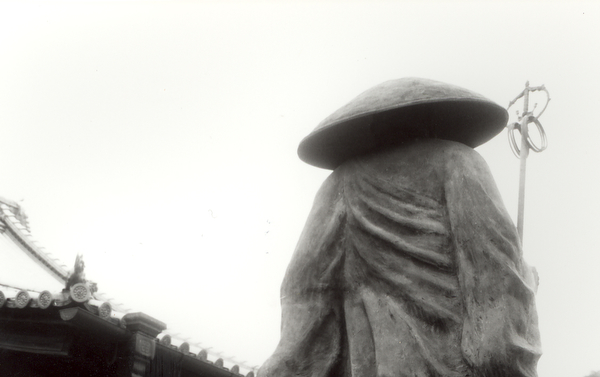
O-settai is a gift given to pilgrims as a help on their journey, often from people who themselves would like to make the pilgrimage but cannot. These gifts are their prayer to Kobo Daishi. I received o-settai almost every day of my pilgrimage–sweets from drivers stopping ahead of me in the road, fruit from grocery shop-owners, advice from other pilgrims, money from old ladies working in the fields by the path and kindness and encouragement from everyone I met. I often reflected that, whatever the pilgrimage’s challenges, surely no one could be despondent when they were constantly offered this warm generosity.
Spriralling Upwards
Entering Kagawa-ken, the final stage of the pilgrimage, I was beginning to look forward to returning home, and by early May near-summer heat had been replaced by erratic and mischievous spring showers. By this point, I knew the routine at each temple well. First a prayer at the main altar, then at the shrine to Kobo Daishi and finally a trip to the payment office where a priest would inscribe my book of temple seals. If I wasn’t too impatient to move on I would normally sit and rest take in the atmosphere of the temple and sometimes chat to the other pilgrims.
(One of the tour bus pilgrims): “Are you walking?”
“Yes, I am.”
“All the way?”
“Yes.”
“Gokurousama-deshita. (Thank you for your trouble.)”
I never got used to the fact that I, the recipient of so much kindness and goodwill, was often thanked for making my journey.
Temple 88, the last and final Shikoku temple is at the end of one of the pilgrimage’s steepest and longest climbs. I arrived there sweaty, with legs like jelly and barely comprehending that I’d reached the end of my journey. I chose not to close the circle and return to temple one but to go straight on to Koya-san, the mountain complex of temples in Wakayama-ken that for centuries has been the headquarters of the Shingon sect. A final visit to Koya-san is the traditional end to the pilgrimage. It was there, strolling through the immense cemetery surrounding the head Shingon temple, that the final realization I’d reached, my walk’s end began to sink in.
“Strong legs and a strong heart?” The former certainly became true. The latter? Well, I hope so. I’ve heard that that if you walk the pilgrimage more than once you never retrace your route but continue on a path spiraling upwards.
I made my way along the forest path as the early morning sun slanted through Koya-san’s ancient pines, and I thought back to a rocky outcrop over the Pacific. There a thousand years ago a man called Kukai sat to meditate while the eagles circled over the sea. And I thought about when I’d walk the pilgrimage again.
